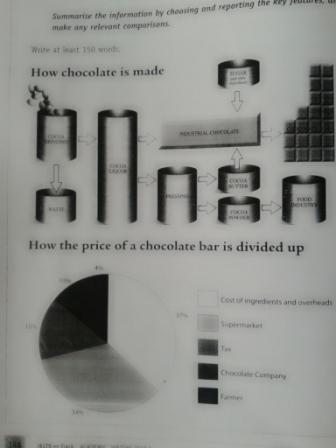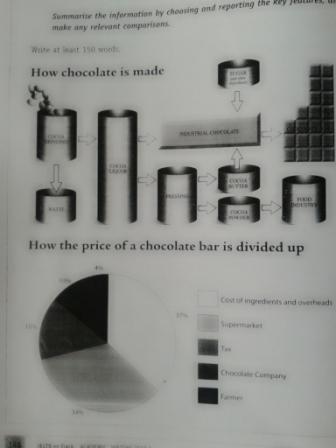The figures reveals the process of how a chocolate bar is produced and the price of a chocolate bar which is allocated into five different sectors. Overall, there are two type of cocoa after pressed. They are cocoa butter used to make chocolate bar and cocoa powder sold to food industry. Moreover, most of the chocolate bar price is allocated to supermarket, and ingredients and overheads.
The first step to make a chocolate bar is to grind the cocoa beans in order to produce cocoa liquor and residuals. The residuals is wasted but the cocoa liquor is used to make chocolate bars and then is pressed to get cocoa butter and cocoa powder. The cocoa powder is purchased by food industry while the cocoa butter is mixed with some cocoa liquor and sugar as well as other ingredients in industrial chocolate. Finally, the mixed materials yield chocolate bar.
Next, the price of a chocolate bar is divided up to only 4% for farmer producing cocoa beans. On the contrary, supermarket gets almost 35% of the price. It is approximately same with the proportion for ingredients and overheads, 37% of the price. Furthermore, 10% and 15% are what the government (tax) and the chocolate company get each.
The first step to make a chocolate bar is to grind the cocoa beans in order to produce cocoa liquor and residuals. The residuals is wasted but the cocoa liquor is used to make chocolate bars and then is pressed to get cocoa butter and cocoa powder. The cocoa powder is purchased by food industry while the cocoa butter is mixed with some cocoa liquor and sugar as well as other ingredients in industrial chocolate. Finally, the mixed materials yield chocolate bar.
Next, the price of a chocolate bar is divided up to only 4% for farmer producing cocoa beans. On the contrary, supermarket gets almost 35% of the price. It is approximately same with the proportion for ingredients and overheads, 37% of the price. Furthermore, 10% and 15% are what the government (tax) and the chocolate company get each.

Writing_Task_1_Choc.jpg
Writing_Task_1_Choc.jpg
